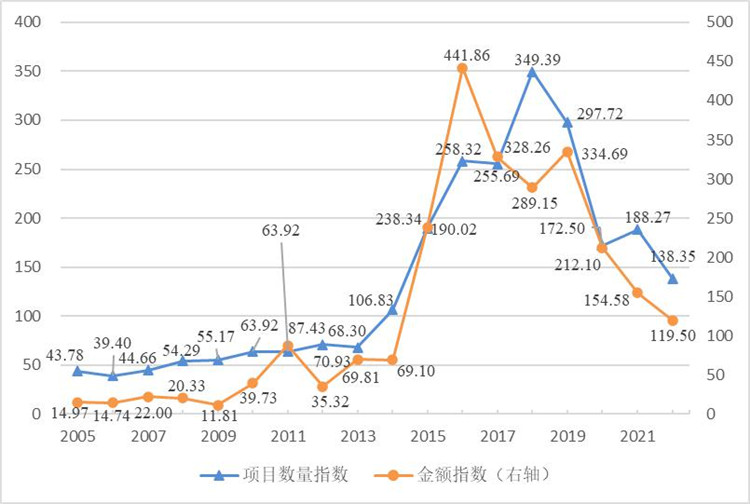The 2022 Report on “Nankai University China’s Outward Foreign Direct Investment (OFDI) Index” Released
Recently, the launch of the book 2022 Report on Nankai University China’s Outward Foreign Direct Investment (OFDI) Index and the Forum on the International Development of Chinese Private Enterprises were held in Beijing. Fang Yongchun, Vice President of Nankai University; Huo Xuewen, Chairman of Bank of Beijing; and Li Chunsheng, Vice President of People’s Publishing House, jointly unveiled the new book. The annual report has been published for six years in a row.
Lu Jing, Director of the Major Programs Office of People’s Publishing House, reviewed the publication and distribution of the “Nankai University China’s Outward Foreign Direct Investment (OFDI) Index” for six consecutive years. Xue Jun, professor of the School of Economics of Nankai University and Director of the Center on Global Economy Research, and Dr. Zheng Yuming jointly released the latest “Nankai University China’s Outward Foreign Direct Investment (OFDI) Index”. Wang Yongzhong, Director of the Energy Research Office of the Institute of World Economics and Politics of the Chinese Academy of Social Sciences; Yan Bing, Deputy Dean of the School of Economics of Nankai University and Director of the Institute for International Economics; and Peng Zhiwei, Dean of the Department of International Economics and Trade of Nankai University made comments and put forward suggestions for optimization in light of China’s strategy on domestic and international circulation.
Liu Yingqiu, Executive Chairman of “Forum 50 for Non-government Economy of China”; Zhang Wencai, Vice President of the Export-Import Bank of China; Xu Lin, Chairman of U.S.-China Green Investment Management Co., Ltd.; and Liu Shan, President of IFENG Finance Institute, delivered keynote speeches on the development of Chinese modernization and the international development of the non-government economy from a global perspective.
The Annual Report of Chinese Private Enterprises’ Outward Foreign Direct Investment Index is completed by the team led by Professor Xue Jun of Nankai University School of Economics, and published and distributed by People’s Publishing House. It has been released for six years since 2017, and was included on the recommended book list of People’s Publishing House in 2021 and 2022. The annual report, which is prepared under the three principles of “uniqueness in the world, statistical yearbook and sustainability”, is intended to become a high-quality and trusted “Nankai China OFDI Index” brand.
“Nankai University’s China OFDI Index”, which is the centerpiece of the report, is prepared based on the database independently established by Professor Xue Jun’s team. Through matching with the two well-known databases of BvD-Zephyr and fDi Markets, this database covers all Chinese enterprises that make OFDI, and classifies them into four categories: state-owned, private, Hong Kong-, Macao-, Taiwan-funded and foreign investment. It is a full-sample database for Chinese enterprises’ outward foreign direct investment that covers investment modes, investment sources, target country (region) for investment, and target industries for investment.
The database covers 20,404 pieces of full-sample data on Chinese enterprises’ OFDI projects in the 18 years from 2005 to 2022, through which we can observe the changing characteristics and trends of private enterprises going global from different perspectives.
If only year-on-year growth was used, it would be difficult to distinguish and compare the overall development level in a given period. The “Nankai University’s China OFDI Index” falls into two categories: sub-indices and composite indices. This series of indexes constructs a six-level index system for “Chinese Private Enterprises' Outward Foreign Direct Investment”, and analyzes the characteristics of private enterprises’ OFDI in terms of source areas, target country (region) and target industry from the two perspectives of M&A investment and greenfield investment, with a total of 582 indices. Data for these indices have been updated since 2005.

Chart showing changes in the number and amount indices of projects invested by Chinese private enterprises under the Belt and Road Initiative from 2005 to 2022
According to Xue Jun, private enterprises have exhibited unique investment characteristics in investment relevant to the Belt and Road Initiative in recent years. First of all, despite the fact that private enterprises prefer investment in developed countries, and investment relevant to the Belt and Road Initiative accounts for a small proportion of the overall OFDI by private enterprises, private enterprises account for more than half of the total Belt and Road investment. Second, private enterprises prefer M&A investment in global OFDI, but prefer greenfield investment relevant to the Belt and Road Initiative.
The report consists of three parts: “Index Analysis”, “Synergy and Outlook” and “Special Analysis”, with a focus on “Structural Transformation, Private Enterprises’ OFDI and Post-industrialization”. It analyzes the impact of OFDI on China’s industrialization process and the important role for private enterprises going global.
The Annual Report of Chinese Private Enterprises’ Outward Foreign Direct Investment Index (2022) provides sufficient data for research on Chinese private enterprises’ OFDI, and makes it possible to systematically analyze the characteristics of Chinese private enterprises’ OFDI, providing a key basis for China’s private enterprises to establish long-term mechanism for going global in the long term.
It is reported that Nankai University inked a strategic cooperation framework agreement with Bank of Beijing in May this year. At this meeting, Professor Xue Jun’s team and Bank of Beijing reached a cooperation intention to develop indices for China’s technology innovation-oriented small and medium-sized enterprises.
(Edited and translated by Nankai News Team.)









